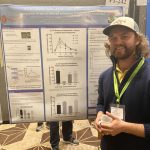Comparison of PFAS concentration in anaerobically digested and autothermal thermophilic aerobically digested biosolids
Presented by: Caroline Alukkal – Graduate Scholar at Purdue University, calukkal@purdue.edu
Co-authors: Linda S Lee
Abstract: Per- and polyfluoroalkyl substances (PFAS) is an emerging contaminant which is present in many of the daily consumer products such as food wrappers, stain resistant clothes and carpets. These products lead to the PFAS in the sewage and finally reach the wastewater treatment plant (WWTP). Sometimes the sewage can be even impacted from the industrial sources and Aqueous film forming foam (AFFF) from fire-fighting sites and air force bases and can have much higher concentration of PFAS than that occur in the normal sewage. Unfortunately, conventional secondary wastewater treatment processes are not capable of removing or mineralizing PFAS. In addition to that, many precursors PFAS that are present in the sewage will undergo degradation under the conditions of wastewater treatment leading to a higher concentration in the effluent than in the influent. This change in the PFAS concentration across the WWTP depends on the treatment and stabilization processes. Since most of the biosolids produced are beneficially land applied, PFAS concentration in the biosolids must be regulated. The changes in the PFAS concentration for anaerobic digestion as well as Autothermal thermophilic aerobic digestion are analyzed and compared. This will help to make informed decisions for the land application of such biosolids.
Biography: Caroline Rose Alukkal is a Ph.D. scholar at Purdue University with research centered on the quantification and remediation of PFAS with main focus on biosolids. She is actively involved in the research on remediation technologies from the Under-Graduate studies. Her expertise in Biotechnology Engineering for the bachelor’s degree and in Environmental Science and Engineering for the master’s degree equips her with innovative solutions for the anthropogenic environmental issues. Her happiness lies in the conservation of environment innovatively but simple.
Linking dissolved organic matter composition to photodegradation of select contaminants
 Presented by: Kailey Beer – Student at University of St. Thomas, beer6864@stthomas.edu
Presented by: Kailey Beer – Student at University of St. Thomas, beer6864@stthomas.edu
Co-authors: Kailey E. Beer, Alyssa B. Risch, Isabella M. Kelly, Stephanie M. Berg, Christina K. Remucal, Kristine H. Wammer
Abstract: Contaminants found in surface waters that undergo photolysis can follow two degradation pathways, direct or indirect. Direct degradation occurs when the contaminant absorbs photons from the sun resulting in degradation. Indirect degradation occurs when dissolved organic matter (DOM), also found in surface waters, is irradiated, producing photochemically produced reactive intermediates (PPRIs), which have the potential to degrade contaminants. The steady-state concentrations of these PPRIs, such as triplet-state DOM (3DOM*), singlet-state oxygen (1O2), and radicals such as hydroxyl radical (OH), depends on the composition of the DOM. This project sourced samples from agricultural, rural, and urban surface waters throughout Minnesota and Wisconsin with a range of DOM composition. Samples were spiked with one of four contaminants, atorvastatin, carbamazepine, cimetidine, or sulfadiazine, irradiated in a photoreactor (=365 nm), and both carbon-normalized indirect and direct photodegradation rate constants were quantified. Relationships between contaminant transformation rates and DOM composition and concentration will be presented; in most cases DOM derived from aquatic systems is more efficient for contaminant transformation.
Biography: Kailey is a senior at the University of St. Thomas where she is majoring in Biochemistry and minoring in Sustainability. She plans on attending graduate school in the future for environmental chemistry and hopes to start a career in environmental consulting.
A look into Wisconsin’s PFAS groundwater standard recommendations
 Presented by: Gavin Dehnert – Postdoctoral Fellow at Wisconsin Department of Health Services, gavin.dehnert@dhs.wisconsin.gov
Presented by: Gavin Dehnert – Postdoctoral Fellow at Wisconsin Department of Health Services, gavin.dehnert@dhs.wisconsin.gov
Co-authors: Sarah Yang, Roy Irving
Abstract: The goal of Wisconsin groundwater and drinking water program (GDWP) is to protect public health by ensuring all Wisconsinites have access to safe drinking water. In a process laid out in State Statue, GDWP develops groundwater standards that protect water from substances that affect human health or impact the water’s taste, color, or odor. GDWP follows a three step process: gather relevant scientific information, select the appropriate standard, and document findings and recommendations. Recently, GDWP released Cycle 11 groundwater standard recommendations. This cycle included 22 substances including 6 pesticides and 16 per- and polyfluoroalkyl substances (PFAS). As detections of PFAS and pesticides increase in Wisconsin groundwater, these groundwater standards can protect our water from substances that can affect human health.
Biography: Wisconsin Water Resources Science and Policy Postdoctoral Fellow, Bureau of Environmental and Occupational Health, Wisconsin Division of Public Health.
Enrichment of legacy and emerging per- and polyfluoroalkyl substances in the sea surface microlayer
 Presented by: Hannah Doane – Graduate Student at MACRL, hannaha.doane@gmail.com
Presented by: Hannah Doane – Graduate Student at MACRL, hannaha.doane@gmail.com
Co-authors: Ralph Mead, Jennifer Harfmann
Abstract: The global transport of per- and polyfluoroalkyl substances (PFAS) is still widely unknown, particularly as it relates to air-sea exchange. This study focuses on the potential transport and enrichment of legacy and emerging PFAS (e.g. HFPO-DA) via the sea surface microlayer (SML), the interface between the hydrosphere and the atmosphere. Twenty-eight PFAS compounds – including four emerging PFAS – were quantified in the SML and the underlying sub-surface water (SSW) at two sites near a tidal bay on the eastern coast of North Carolina. The distribution of PFAS in both SML and SSW was dominated by PFOS with values of 0.9 to 30.3 ng/L and 1.6 to 5.1 ng/L respectively. Enrichment factors (CSML/CSSW) were highest for legacy PFAS (range: 0.2 to 19.6) and lowest for emerging PFAS (range: 0.7 to 7.0). This work emphasizes that the SML could be key in contributing to air-sea exchange and subsequent long-range transport of legacy PFAS compounds. Furthermore, as the number of emerging PFAS compounds continues to increase, the SML may be a critical boundary layer in understanding PFAS global transport.
Biography: Hannah Doane is a graduate student at UNCW and her research is conducted through the MACRL group. She received her B.S. in Chemistry in 2019 and has been working with MACRL since 2017.
Triclosan adsorption to microplastic fibers alters microbial colonization of plastic surfaces
 Presented by: Karl Gaisser – Graduate Student at Loyola University Chicago, kgaisser@luc.edu
Presented by: Karl Gaisser – Graduate Student at Loyola University Chicago, kgaisser@luc.edu
Co-authors: Karl Gaisser, Justine Nguyen, John Kelly
Abstract: Microplastics are a contaminant of emerging concern in freshwater habitats worldwide. Within aquatic habitats microplastic surfaces are colonized by microorganisms and can adsorb other contaminants, including pharmaceuticals and personal care products, creating hot-spots for microbe-pharmaceutical interactions. Triclosan is an antimicrobial agent found in a variety of personal care products, and it is also a contaminant of concern in urban freshwater environments. Previous work has shown that triclosan can affect microbial assemblages in freshwater habitats, and that it can be detected on plastic surfaces in these habitats. We used a microcosm-based approach to explore the interactions between triclosan and microbes on microplastic surfaces. We incubated acrylic, nylon, and polyester fibers with or without adsorbed triclosan in water collected from the Chicago River for 30 days. DNA-based analysis of microbial assemblages attached to the fibers and in the surrounding water indicated that the presence of triclosan resulted in lower diversity and a shift in microbial assemblage composition both on the microplastic surface and in the water column. Differential abundance analysis shows that certain phyla have more abundant gene copies in the triclosan treatments, including cyanobacteria and proteobacteria.
Biography: Karl Gaisser is a second year M.S. graduate student in the Kelly Lab at Loyola University Chicago. He received a B.S. degree in biology from Indiana University Bloomington in 2016 and worked in the biotechnology industry for a few years prior to matriculating to Loyola University Chicago. His research interests include examining how novel contaminants affect freshwater microbial ecosystems.
Porewater and surface water analysis in the tidal freshwater Potomac River for the presence of pharmaceutical and personal care products
 Presented by: Carissa Hunter – Student at George Mason University, chunte14@gmu.edu
Presented by: Carissa Hunter – Student at George Mason University, chunte14@gmu.edu
Co-authors: Carissa Hunter, Gregory Foster
Abstract: Porewater is the water held between the pores within soil or sediment, and it is a very under-studied sub-compartment in environmental chemistry. It can provide valuable information regarding environmental fate because it regulates the transport of chemicals into and out of sediment. Surface water and porewater were collected at two sites in the tidal freshwater Potomac River, in order to analyze the presence of Pharmaceutical and Personal Care Products (PPCPs). Surface water was collected using a submersible pump, while porewater was collected using a stainless-steel Push Point Sampler. Water samples were filtered and then extracted using Supel- Select HLB solid-phase extraction cartridges. Elution with 2 X 0.5 mL of acetonitrile was done prior to analyzing by liquid chromatography- mass spectrometry. It was found that Triamterene, Metoprolol, Propranolol, Fexofenadine and Glipizide showed high concentrations in both surface water and pore water at both sites with concentrations of 0.015-56 ng/L. Porewater concentrations, however were higher in the samples from Anacostia Waterfront Park in comparison to Kenwilworth Marsh, where surface water concentrations were higher. This is expected as Anacostia Park is located adjacent to a wastewater treatment plant with potential accumulation of PPCPs on sediment, where no known source is near Kenwilworth Marsh.
Biography: Carissa Hunter earned her B.S degree in Biology with a minor in Chemistry from Howard University in 2015. Since then, she earned a M.S degree in Chemistry (2018) from George Mason University, and is now pursuing her PhD at GMU under the guidance of Dr. Gregory Foster. Her research interests include studying micro-pollutants and their ecological risks to human health and wildlife, whilst using LCMS for analysis. Carissa enjoys spending time with family and friends outside of research.
Untargeted high resolution mass spectrometry in conjunction with traditional targeted mass spectrometry aids in the characterization of complex environmental mixtures.
 Presented by: Alyssa Mianecki – Graduate Student Researcher at University of Iowa, alyssa-mianecki@uiowa.edu
Presented by: Alyssa Mianecki – Graduate Student Researcher at University of Iowa, alyssa-mianecki@uiowa.edu
Co-authors: Gregory H. LeFevre
Abstract: Contaminants of emerging concern (CEC) are continually released from wastewater treatment plants (WWTP) to surface waters. Many WWTPs discharge into small, ephemeral streams including Muddy Creek of eastern Iowa, thus treated wastewater is a significant proportion of overall stream discharge. Muddy Creek has been extensively studied for the presence of CECs, especially for pharmaceuticals and personal care products (PPCP) (Zhi et al., 2020). Although many PPCPs have been defined spatiotemporally within Muddy Creek many CECs remain undefined due to the nature of traditional targeted environmental analysis. For this study, untarged high resolution mass spectrometry was utilized to better characterize the Muddy Creek water. Water samples were analyzed using a Q-Exactive Orbitrap in both positive and negative mode and then analyzed with Compound Discoverer. Identified compounds were ranked on a scale with five levels of confidence ranging from exact mass up to confirmed structure (Schymanski et al., 2014). Untargeted analysis allows for a greater swath of chemicals to be discovered in the environment than traditional targeted techniques alone and aids in the characterization of complex environmental mixtures.
Biography: Alyssa Mianecki is an Environmental Engineering PhD student at the University of Iowa. She graduated from UW-Stevens Point with a BS in Water Resources Management and studies contaminants of emerging concern in environmental samples. Using mass spectrometry, Alyssa’s goal is to characterize complex samples to inform environmental health decisions.
Prioritization and assessment of flame retardants under Canada’s Chemicals Management Plan: Looking back and priorities moving forward
Presented by: Peter Mochungong – Scientific Evaluator at Health Canada, peter.mochungong@canada.ca
Co-authors: Leona MacKinnon, Angelika Zidek
Abstract: Canada’s Chemicals Management Plan (CMP) is an initiative aimed at reducing the risk posed by chemicals to Canadians and their environment. Under the CMP, the Government of Canada (GoC) is responsible for prioritizing and assessing those substances on the Domestic Substances List (i.e., substances in commerce in Canada between 1984-1986) under the purview of the Canadian Environmental Protection Act (CEPA), 1999. A number of flame-retardants were identified as priorities in 2006 and have since been assessed including tributyl phosphate (TBP), tetrabromobisphenol A (TBBPA), dechlorane plus (DP), decabromo diphenyl ethane (DBDPE), hexabromocyclo dodecane (HBCD) and tri(chloroethyl) phosphate (TCEP). Those with identified human health or ecological concerns are subsequently risk managed. Recognizing that new information continues to be generated that could help inform the identification of substances of concern; a regular review of available information is undertaken by the GoC. The approach, known as the Identification of Risk Assessment Priorities, enables the GoC to communicate how emerging issues are tracked, and to identify and prioritize substances requiring further work. Through this approach, 36 substances that are structurally related to organic flame-retardants previously assessed under the CMP or potentially used as flame-retardants have been recommended for further scoping.
Biography: Dr. Peter Mochungong holds a PhD in Environmental Health Sciences from the University of Southern Denmark. He first joined Health Canada 9 years ago as NSERC Visiting Fellow to Government of Canada Laboratories; conducting environmental contaminants research, especially the presence and fate of volatile and semi-volatile organic contaminants in air and consumer products. Dr. Mochungong is passionate about research, developing new methodologies and interpretation of toxicology and exposure data on chemical risk assessment to inform evidence-based policies and regulations. Dr. Mochungong currently works as Scientific Evaluator at Health Canada.
Micro-solid phase extraction method for analyzing PFAS in water
 Presented by: Batool Murtadha – Graduate Student at George Mason Univeristy
Presented by: Batool Murtadha – Graduate Student at George Mason Univeristy
Co-authors: Songjing Yan, Upal Ghosh, and Gregory Foster
Abstract: Per- and polyfluoroalkyl substances (PFAS) have been under investigation for environmental and public health risks since being detected at parts-per-million concentrations in groundwater at installations using firefighting foams. Our project is focused on developing passive equilibrium sampling technology using customized polymeric materials to measure PFAS in natural waters, by characterize the isotherm behavior of individual PFAS, and develop a reliable solid phase extraction (SPE) microanalysis of PFAS in water. Our analysis is being conducted using 3 mL custom packed SPE cartridges containing 50 mg of Strata PFAS WAX / 12 mg of graphitized carbon black (GCB) sorbents. Water (100 mL) is extracted and the eluents (0.5 mL of MeOH + 0.3% NH4OH) are eluted into 2 mL autosampler vials without the need for solvent volume reduction. The method has yield recoveries of 24 PFAS from water ranging from 41% Perfluorotridecanoic acid to 91% Perfluorononane sulfonic acid. Surrogate recoveries perfluoro-n-[1,2-13C2]hexanoic acid, perfluoro-n-[1,2-13C2]decanoic acid and N-deuterioethylperfluoro-1-octanesulfonamidoacetic acid were 103%, 83% and 89%. The optimized micro-solid phase extraction method is capable of measuring the PFAS concentration and has given an efficient and firm result, plus a cost-effective and saves time. Further, this method will be used for studying surface and pore water samples.
Biography: Batool was born in Iraq and raised in Ohio. A first-year Ph.D. student researching in Dr. Gregory Foster’s lab in environmental chemistry. She did earn her bachelor’s degree in 2016 from Walsh University in chemistry. she finished her master’s degree in chemistry in 2020 from the university of Dayton. Her master’s thesis researched in organic chemistry area about the development of a new synthesis of organophosphate that controls its stereochemistry.
Treatment of mixed chlorinated solvents and 1,4-dioxane in groundwater – Testing of two biodegradation strategies
Presented by: Donald Pope – Scientist at GHD, Donald.PopeJr@ghd.com
Co-authors: Jennifer Wasielewski, Ryan Thomas, Sophia Dore
Abstract: 1,4-dioxane is often found where chlorinated volatile organic compounds (CVOC) are present in groundwater. CVOC and 1,4-dioxane are present in the subsurface at a site in California. A laboratory treatability study was performed to assess the effectiveness of biodegradation for treatment of soil and groundwater from the site under sequential anaerobic / aerobic conditions and under aerobic conditions using a co-metabolic pathway.
Under anaerobic conditions reductive dechlorination of chlorinated compounds to ethane and ethene can occur. However 1,4-dioxane does not degradedunder anaerobic conditions, however it can be degraded under aerobic conditions. Chlorinated compounds such as PCE and TCE can be degraded under aerobic conditions via a cometabolic pathway.
Two strategies were tested to treat the mixed chlorinated solvent/1,4-dioxane plume. The first was to to treat chlorinated solvents under anaerobic conditions and subseqently the conditions were made aerobic to treat 1,4-dioxane. The second stragegy was for 1,4-dioxane and CVOC to be degraded together under aerobic conditions by a co-metabolic pathway.
The results of this study showed that CVOC were removed under anaerobic conditions and under aerobic, co-metabolic conditions; however, greater treatment was observed under anaerobic conditions. Degradation of 1,4-dioxane was observed under both sets of conditions.
Biography: Donald runs the GHD Innovative Technology Laboratory. Don has 17 years’ experience in performing analytical testing on groundwater, soil, and gas samples in the laboratory in Niagara Falls. The analyses are performed in support of treatability studies and in support of forensic work. He is also in charge of the preparation and setup of the treatability studies conducted in the lab. The treatability studies include chemical oxidation, enhanced bioremediation, solidification and stabilization, wastewater testing and dewatering studies.
Atmospheric dry deposition of legacy and emerging per- and polyfluoroalkyl substances (PFAS) in North Carolina
 Presented by: Ariel Potter – Student at University of North Carolina Wilmington, aap3450@uncw.edu
Presented by: Ariel Potter – Student at University of North Carolina Wilmington, aap3450@uncw.edu
Co-authors: Megumi S. Shimizu, Jennifer L. Harfmann, G. Brooks Avery, Robert J. Kieber, Ralph N. Mead, Stephen A. Skrabal, Joan D. Willey
Abstract: Per- and polyfluoroalkayl substances (PFAS) are ubiquitous anthropogenic pollutants but little is known about atmospheric dry deposition of these compounds. Fluxes of six PFAS were quantified at six locations across North Carolina from December 2018 to January 2021. Two legacy PFAS and four emerging (e.g. HFPO-DA) PFAS were quantified in each location. ΣPFAS fluxes for Wilmington ranged from 0.04-19 ng/m2/day for years 2019 and 2020, with PFOS and PFMOAA being the dominant compounds. In comparison, samples collected across North Carolina in 2018 and 2019 had ΣPFAS fluxes from below the method quantification limit to 50 ng/m2/day, with PFOS being the dominant compound. Annual dry deposition of PFAS in Wilmington for years 2019 (n = 23) and 2020 (n = 15) was 740 and 340 ng/m2 respectively. While PFOS and PFOA production in the United States was voluntarily phased out by 2002 and 2015 respectively, there are still sources of PFOS and PFOA to the atmosphere in the United States. This study is the first to show that dry deposition is a removal mechanism for emerging PFAS from the atmosphere and highlights the need for further investigation into their atmospheric lifetime and degradation pathways.
Biography: Ariel Potter is a graduate student seeking a M.S. in Chemistry at the University of North Carolina Wilmington (UNCW). She earned B.S. degrees in Marine Biology and Chemistry from UNCW in 2018. During her undergraduate years, her research focused on the effects of oyster aquaculture on seagrass in intracoastal North Carolina. Her current research focuses on quantifying and identifying per- and polyfluoroalkyl substances (PFAS) in dry atmospheric deposition across the state of North Carolina.
Bioaccumulation of polycyclic aromatic hydrocarbons (PAH) and per- and polyfluoroalkyl substances (PFAS) in river biofilms
 Presented by: Gabriela Reichert – PhD student at Federal University of Paraná/ Karlsruhe Institute of Technology, gabrielareichertamb@gmail.com
Presented by: Gabriela Reichert – PhD student at Federal University of Paraná/ Karlsruhe Institute of Technology, gabrielareichertamb@gmail.com
Co-authors: Stephan Hilgert, Stephan Fuchs, Julio César Rodrigues de Azevedo
Abstract: Biofilms are complex communities of bacteria, algae, fungi, and other microorganisms. Biofilms are found in many natural and human-mediated habitats. Their main characteristic is the ability to attach to different surfaces, and to colonize different ecosystems. Another important feature is the capacity to absorb substances, including nutrients, organic matter, and pollutants. Due to this capacity, they could indicate the presence of pollutants in the natural environment. The main goal of this research was to analyze biofilm collected from two sampling points in a river in southern Germany: one upstream and one downstream a small WWTP to assess the accumulation of polycyclic aromatic hydrocarbons (PAH) and per- and polyfluoroalkyl substances (PFAS). Sediment and water samples were also analyzed. 14 PAH were detected in the samples. PFAS were not detected in biofilm and sediment. The concentrations detected were higher for the biofilm and the sediment samples collected downstream of the WWTP. The water samples did not present significant differences between the two sampling points. Biofilm can be an adequate matrix for time-integrating analyses. Research with other substances and over longer periods should be performed.
Biography: PhD student in the field of Environmental Engineering and Water Resources. The focus of my research is environmental chemistry, emerging contaminants and urban pollution. I am currently studying the bioaccumulation of emerging contaminants in stream biofilms.
Contributions of photochemically-produced reactive intermediates to contaminant photodegradation in natural surface waters
 Presented by: Alyssa Risch – Undergraduate research assistant at University of St. Thomas, risc9782@stthomas.edu
Presented by: Alyssa Risch – Undergraduate research assistant at University of St. Thomas, risc9782@stthomas.edu
Co-authors: Kailey E. Beer, Isabella M. Kelly, Stephanie M. Berg, Christina K. Remucal, Kristine H. Wammer
Abstract: Some chemical contaminants in natural waters can undergo direct photodegradation when they absorb photons from sunlight. Some contaminants can also undergo indirect photodegradation when dissolved organic matter (DOM) in surface waters absorb photons and become excited, resulting in formation of photochemically-produced reactive intermediates (PPRI). These PPRIs, such as triplet state DOM (3DOM*), singlet oxygen (1O2), and radical species including the hydroxyl radical (∙OH), may then react with and degrade the contaminant. In order to determine which of these PPRIs contribute most to degradation of selected pharmaceuticals in various surface waters, quenchers were used in photolysis experiments. Water samples were spiked with a contaminant (sulfadiazine, carbamazepine, or atorvastatin) and a quencher: 1,4-diazabicyclo[2.2.2]octane (DABCO; 1O2 quencher), sorbic acid (3DOM* quencher), or isopropanol (radical quencher). Samples were then photolyzed (365 nm bulbs) and degradation rates determined. The decrease in rate constants observed with the addition of DABCO and sorbic acid indicates that 3DOM* and 1O2 contribute to the degradation of all three contaminants, with a less pronounced effect on atorvastatin than sulfadiazine or carbamazepine. ∙OH may also contribute to carbamazepine’s degradation.
Biography: Alyssa is a senior biochemistry major at the University of St. Thomas. She is also minoring in sustainability, English, and mathematics. After graduating in May, she hopes to start a career in the environmental science field, such as water quality monitoring.
Sponge nanocomposites as a platform for the remediation of heavy metals and other emerging contaminants
 Presented by: Benjamin Shindel – PhD Student at Northwestern University, benshindel@u.northwestern.edu
Presented by: Benjamin Shindel – PhD Student at Northwestern University, benshindel@u.northwestern.edu
Co-authors: Stephanie Ribet, Caroline Harms, Vinayak Dravid
Abstract: Lead pipes have been said to have brought about the collapse of the Roman empire, and mercury poisoning caused the death of China’s first emperor, the builder of the Great Wall and the Terracotta Army. Heavy metal poisoning is famous as an ancient malady, yet today, heavy metals still account for a large fraction of the global health burden, causing hundreds of thousands of deaths every year. Though there is extensive literature on emerging strategies involving nanotechnology for remediating heavy metals from water, soil, and air, it remains difficult to deploy these nanoscale solutions on a gigaton level. The Dravid group is developing and studying platform approaches for environmental remediation by generating nanocomposite materials to remediate and recover heavy metals, among other contaminants, from water in a reusable, sustainable fashion. This brief presentation will address the challenges and benefits of using this type of platform approach, including several cross-applicable to many areas of emerging contaminants. We will discuss predicting adsorption isotherms from first principles, the understated importance of surface area in adsorbent design, and the use of thermal characterization methods applicable for complex membranes.
Biography: Ben Shindel is a materials science PhD student in the Dravid group at Northwestern University. He studies materials for environmental remediation.
Measuring Contaminants of Emerging Concern in Illinois
 Presented by: Jacob Smith – Student at Southern Illinois University Edwardsville, jsmitbd@siue.edu
Presented by: Jacob Smith – Student at Southern Illinois University Edwardsville, jsmitbd@siue.edu
Co-authors: Katherine Maloof, Kevin Tucker
Abstract: Contamination to the water supply comes from many origins including agricultural, industrial, and domestic sources. Despite recent attention to agricultural water pollution, there are contaminants of emerging concern (CEC) not related to agriculture that are showing up in natural water sources everywhere. CECs include a broad range of compounds that come from pharmaceuticals like antibiotics and hormones, personal care products like dietary supplements and preservatives, and nanomaterials. These compounds end up in the water supply due to improper disposal of consumer waste which is then discharged from wastewater treatment plants to freshwater supply or applied to crops. In an effort to monitor water contamination statewide, water samples will be taken from multiple natural sources throughout Illinois and tested for various CECs. These samples will be purified via solid phase extraction and quantified via liquid chromatography mass spectrometry. Our goal is to create a geographic information system and database to aid in the communication of analytical results and advance the removal of CECs from water sources.
Biography: Jacob Smith is an undergraduate chemistry student at Southern Illinois University Edwardsville. He has spent more than two years as an undergraduate assistant in Dr. Kevin Tucker’s laboratory, where they focus on quantitative chemical analysis, especially pertaining to pharmaceuticals and personal care products in environmental samples. Upon the completion of his bachelor’s degree, he plans to continue my education in Southern Illinois University Edwardsville’s graduate chemistry program, leading to a career in chemical research.
A novel bismuth oxyhalide/carbon quantum dot photocatalyst for the degradation of trichloroethane
 Presented by: Brandon Stieve – Graduate Student at Ball State University, brandonstieve@icloud.com
Presented by: Brandon Stieve – Graduate Student at Ball State University, brandonstieve@icloud.com
Abstract: Trichloroethane (TCE) has been widely used for a number of industrial processes since the early 20th century, and as a result is also the most abundant contaminate in US groundwater. The US EPA lists TCE as a known carcinogen & is carcinogenic by all routes of exposure. Semiconductor photocatalysts have been increasingly studied for the remediation of toxic compounds. In this presentation, we describe a novel approach to enhance the photocatalytic activity of bismuth oxyhalides (BiOX) semiconductors by canon quantum dots sensitization. Varying sizes of carbon dots were prepared by a microwave synthesis using urea & citric acid as precursors. Subsequently, a specific wt% of carbon dots were integrated into different BiOX nano sheets by a surfactant-assisted hydrothermal method at 80°C. The catalytic activity of BiOCl, BiOBr, & BiOI along with there carbon dot-integrated composite were evaluated in the light-activated degradation of rhodamine B dye. Pristine BiOX photocatalysts displayed efficient degradation of rhodamine B with the activity order of BiOCl > BiOBr > BiOI. Integrating carbon dots into BiOX nano sheets demonstrated encased photocatalytic activity. The new composite material are promising photocatalysts for the degradation of TCE & other chlorinated volatile organic compounds
Biography: I am a student from Ball State Universities Graduate Chemistry Program. I enjoy bike riding & hiking through nature. my future plan is to enroll in a chemistry PhD program, beyond that I plan on working on pure research in environmental chemistry.
Optimization of Granular Activated Carbon Treatment of Algal Toxins – a laboratory study
Presented by: Jennifer Wasielewski – Scientist at GHD, jennifer.wasielewski@ghd.com
Co-authors: Donald Pope Jr, Sophia Dore, Ryan Thomas, Teresa Misiti
Abstract: Granular activated carbon (GAC) can be used to remove algal toxins such as microcystin from drinking water. In order to confirm the effectiveness of GAC for treating microcystin treatability column tests were completed using two different types of GAC to determine the most effective type of carbon to be used for treatment of microcystin during the upcoming bloom season. Arsenic has been found in drinking water treated with GAC previously. To evaluate the potential of arsenic leaching from the GAC, column tests were conducted. Columns were set up containing the two selected GAC types and effluent was periodically monitored for total and soluble arsenic during 10 days of continuous operation.
The results indicated which carbon performed best for adsorption of microcystin This column operated for 25 days of lab-scale operation without breakthrough. The equivalent of 21.5 mg of microcystin would be absorbed per pound of GAC in the full-scale filter vessels. The results of the arsenic testing indicate that the initial arsenic concentrations in both columns were well below the EPA MCL. Moreover, within 3 days of continuous flushing, effluent arsenic concentrations in both columns decreased to near the raw water (influent) concentration for the duration of the 10-day flush period.
Biography: Jennifer Wasielewski is a member of the Innovative Technology Group at GHD based in Niagara Falls, New York. She performs analytical testing on groundwater, soil, and gas samples in their laboratory in Niagara Falls. She performs analyses including microbial analyses, UV/Vis spectroscopy, GC and GC/MS spectroscopy, metals, and Kjeldahl nitrogen analysis. Jennifer also assists with the preparation and setup of treatability studies on groundwater and soil samples. The treatability studies include chemical oxidation, enhanced bioremediation, and solidification and stabilization.
Defluorination of PFOA and PFOS alters their toxicity in a hepatocyte and hepatic stellate cell co-culture system
Presented by: Yi Wen – Graduate Student at University of Illinois at Urbana-Champaign, yiwen4@illinois.edu
Co-authors: Saeed Ahmad, Hyeon Ryoo, Zekun Liu, Jinyong Liu, Gregory H. Underhill, Joseph Irudayaraj
Abstract: Perfluorooctanoic acid (PFOA) and perfluorooctanesulfonic acid (PFOS) are two of the most widely used fluorosurfactants in the global industry. They are extremely persistent in the environment and have long half-life in humans. Recent efforts have been made to degrade or defluorinate long-chain perfluoroalkyl substances (PFAS) to reduce their toxicity. But little biological validation has been performed to demonstrate the reduction in toxicity of these defluorinated chemicals. A co-culture system of human hepatic stellate cells and spheroids formed of hepatocellular carcinoma cell HepG2 was designed to mimic human liver in vitro. This system was used as a model to study the toxicity of defluorinated PFOA and PFOS versus their intact forms. Both types of cells are evaluated on the different aspects of the PFAS toxicity, including cytotoxicity, metabolic toxicity, and epigenetic toxicity.
Biography: Yi is a Ph.D. candidate in Dr. Joseph Irudayaraj Lab. He holds a M.S. in Bioengineering from University of Illinois as well as a B.S. in Biological Engineering and a B.S. in Biochemistry from Purdue University. He believes in translating the cutting-edge biology knowledge into tools to explore and reverse the epigenetic toxicity effects of environmental toxicants. He also works on targeted drug delivery with nanoparticles. Yi also has passion in teaching the next generation of bioengineers.
Photochemical fate of quinone outside inhibitor fungicides
 Presented by: Ronan Winkels – student at University of St. Thomas, wink8063@stthomas.edu
Presented by: Ronan Winkels – student at University of St. Thomas, wink8063@stthomas.edu
Co-authors: David M. Cwiertny, Kristine H. Wammer
Abstract: Quinone Outside Inhibitor (QOI) fungicides are heavily used throughout the US in quantities of up to 16,000 kg per county. However, little is known about their environmental fate or potential for transformation via various environmentally-relevant processes. QOI are suspected to have neurodegenerative effects, making their potential appearance in agriculturally impacted drinking water supplies a serious threat. The goal of this study was to investigate the potential for direct and indirect phototransformation of four QOIs: dimoxystrobin, fluoxastrobin, kresoxim-methyl, and fluoxastrobin. Photolysis experiments were performed using a solar simulator in both aqueous solutions and bound to surfaces. In aqueous solutions these compounds were shown to undergo photolysis directly; photolysis rates were enhanced in the presence of nitrate and nitrite indicating indirect photolysis may also be important. Direct photolysis was also observed when on a solid surface. Additionally, the photoproducts in each of these conditions are more hydrophilic, potentially allowing them to more easily travel into a drinking water supply than the parent QOI.
Biography: Senior undergraduate chemistry major at the University of St. Thomas
Photocatalytic degradation of per- and polyfluoroalkyl substances using nanoscale zero-valent iron under ultraviolet light
Presented by: Chunjie Xia – Student at Southern Illinois University Carbondale, chunjie.xia@siu.edu
Co-authors: Xian Lim, Shuo Qu, Linkon Bhattacharjee, Ji Zhang, Jia Liu
Abstract: Degradation of per- and polyfluoroalkyl substances (PFAS) is an imminent task owing to their global distribution, persistence, and toxicity. In this study, degradation of perfluorooctanoic acid (PFOA), perfluorononanoic acid (PFNA), and perfluorooctane sulfonate (PFOS) were investigated using nanoscale zero-valent iron (nZVI) under different light sources. Impacts of oxygen content and nZVI concentration were also investigated. The highest degradation rates of PFOA, PFNA, and PFOS were 97.6, >99.9, and 98.5% under UVC light without presence of O2. Shorter chain perfluorocarboxylic acids (PFCAs) bearing C4 – C7 and fluoride ions were detected as the main byproducts during PFOA and PFNA degradation, however, currently only fluoride ions were detected during PFOS degradation. In comparison, PFOA, PFNA, and PFOS were not degraded under UVA, visible light, and in the dark. The degradation rates of the PFAS were also increased with the increase of nZVI concentrations in the range of 1-100 mg/L. The degradation rates of PFNA were comparable with or without O2, comparatively, the degradation rates of PFOA and PFOS without O2 were higher than those with O2. The optimal method developed in this study can be readily applied for treating environmental media contaminated with PFAS.
Biography: Chunjie got a Bachelor Degree from China University of Mining and Technology, and Ph.D. Degree from Beijing University of Chemical Technology. Chunjie has more ten years research experiences with in-depth knowledge of various cell cultivation, filtration techniques, and chromatographic approaches. Currently, Chunjie is a research assistant in College of Engineering at Southern Illinois University Carbondale, working on the degradation of PFASs and other organic contaminants by using nanoscale zero-valent iron.